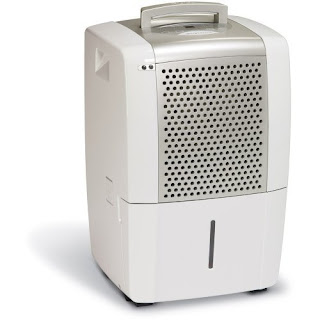
A dehumidifier is mostly a household appliance that reduces the level of humidity in the air, usually for health reasons, as humid air can can cause mold and mildew to grow inside homes, which has various health risks. Relative humidity is preferably 30 to 50%. Very high humidity levels are also unpleasant for human beings, can cause condensation and can make it hard to dry laundry or sleep. Higher humidity is also preferred by most insects, including clothes moths, fleas and cocroaches. Dehumidifiers are used in industrial climatic chambers for keeping certain level of humidity.
Mechanical/refrigerative dehumidifiers, the most common type, usually work by drawing moist air over a refrigerated coil with a small fan. Since the saturation vapor pressure of water decreases with decreasing temperature, the water in the air condenses, and drips into a collecting bucket. The air is then reheated by the warmer side of the refrigeration coil. This process works most effectively with higher ambient temperatures with a high dew point temperature. In cold climates, the process is less effective. They are most effective at over 45% relative humidity, higher if the air is cold.Electronic dehumidifiers use a peltier heat pump to generate a cool surface for condensing the water vapour from the air. This type of dehumidifier has the benefit of being very quiet when in use as there is no mechanical compressor. This design is mainly used for very small dehumidifiers due to the simple design and low cost of parts.
Air Conditioners usually act as dehumidifiers when they chill the air and thus need to handle the accumulated water as well. Newer window units use the condensing coil and fan to evaporate the accumulated water into the outdoor air, while older units simply allow the water to drip outside. Central air conditioning units need to be connected to a drain.
An air conditioner is very similar to a dehumidifier. Air in a dehumidifier passes over a series of cooling coils (the evaporator) and then over a set of heating coils (the condenser). It then goes back into the room as dryer air with its temperature elevated.
However in an air conditioner, air passes over the cooling coils (the evaporator) and then directly into the room. The heated freon then goes through a tube outside the house and into the heating coils (the condenser) and outside air passes over it and then stays outside. The water which condenses on the evaporator in a dehumidifier is caught in the drain pan or drain hose. The water that condenses on the evaporator in an air conditioner runs thorough a duct to the outside of the window.
Click here to purchase your Dehumidifier today!




No comments:
Post a Comment